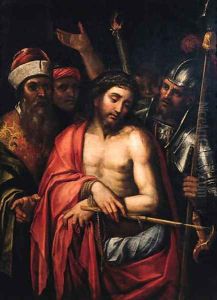School Of Brescia Paintings
The School of Brescia doesn't refer to a single artist but to a group of painters and artists active in the city of Brescia, in northern Italy, between the 15th and 17th centuries. This school of painting was part of the larger Lombard tradition and was influenced by the Venetian School. It is particularly notable for its contributions to the development of Renaissance and Mannerist art in the region.
The city of Brescia was a significant cultural center during the Renaissance, fostering a distinctive style that combined local traditions with influences from neighboring art centers such as Venice and Milan. One of the earliest and most influential artists associated with the School of Brescia was Vincenzo Foppa, who was active in the second half of the 15th century and is often considered the founder of the Brescian school. His work incorporated elements of Lombard realism and Venetian colorism.
In the 16th century, the School of Brescia saw the emergence of artists like Moretto da Brescia (Alessandro Bonvicino) and his pupil, Giovanni Battista Moroni, who are both renowned for their portraits and religious scenes, characterized by a keen observation of detail and subtle use of color. Moretto's work, in particular, combined the influence of the Venetian School with a distinctive attention to naturalism and light.
Girolamo Romanino was another prominent figure of the School of Brescia. His style was more expressive and less restrained than that of Moretto, with a strong use of color and dynamic compositions reflecting the transition to Mannerism. Romanino's frescoes in the Chapel of Saint Joseph in the Church of San Giovanni Evangelista in Brescia are among his most celebrated works.
The School of Brescia's influence continued into the 17th century with artists like Francesco Maffei, whose baroque style was influenced by Venetian painting, and more specifically by the works of Tintoretto and Veronese. The School of Brescia's legacy is characterized by a blend of technical skill, a rich palette, and a deep understanding of human emotion, all of which contributed to the development of northern Italian art.
